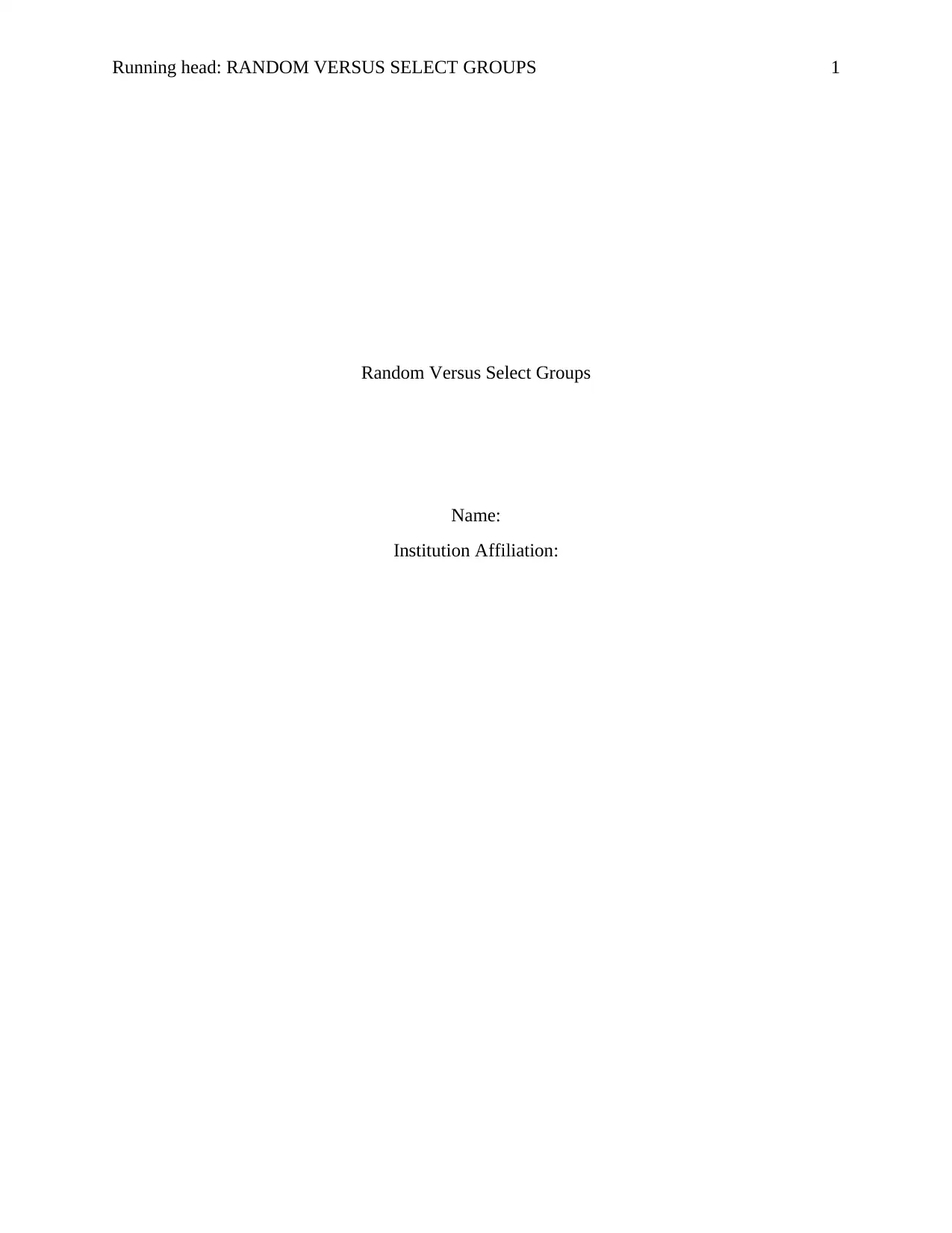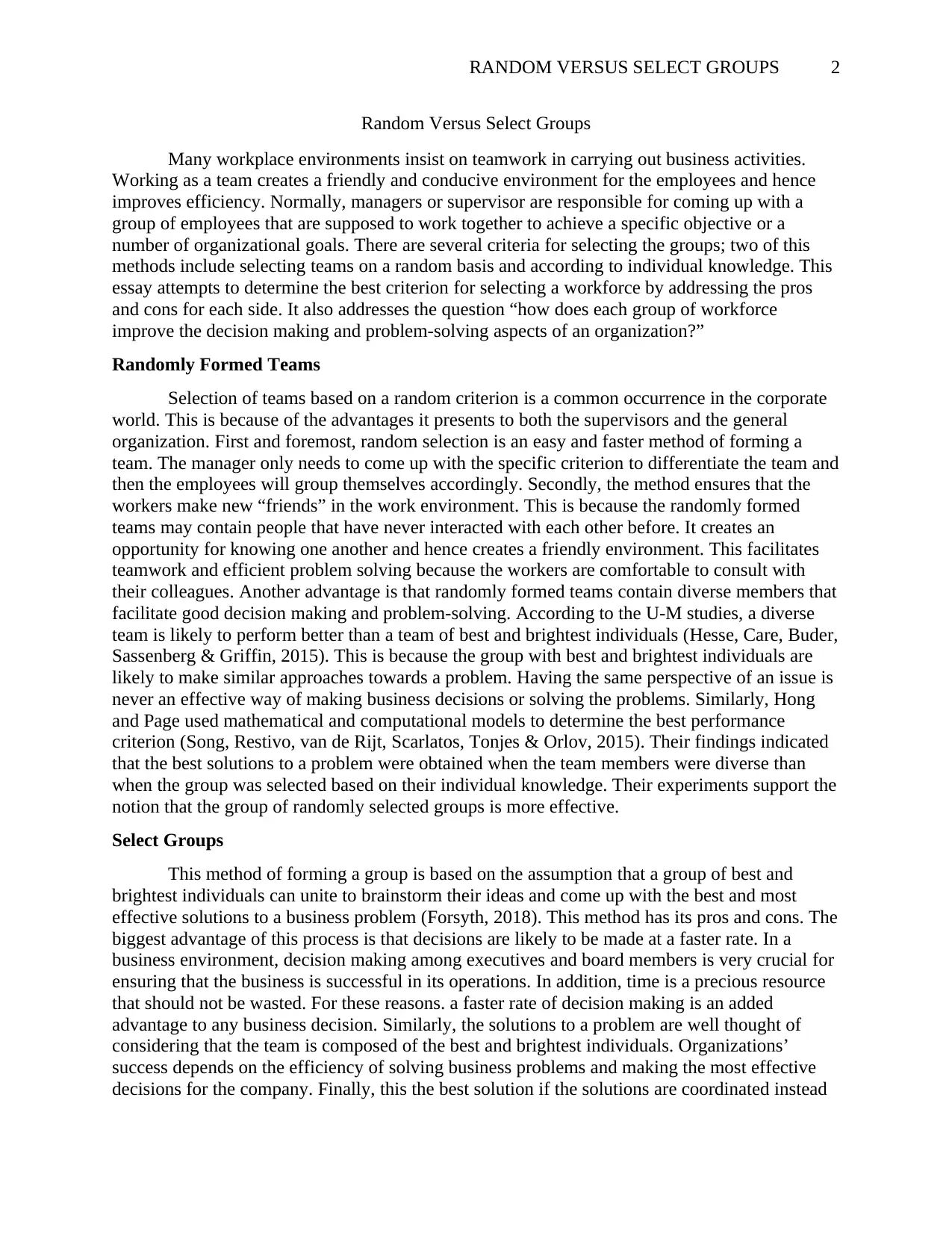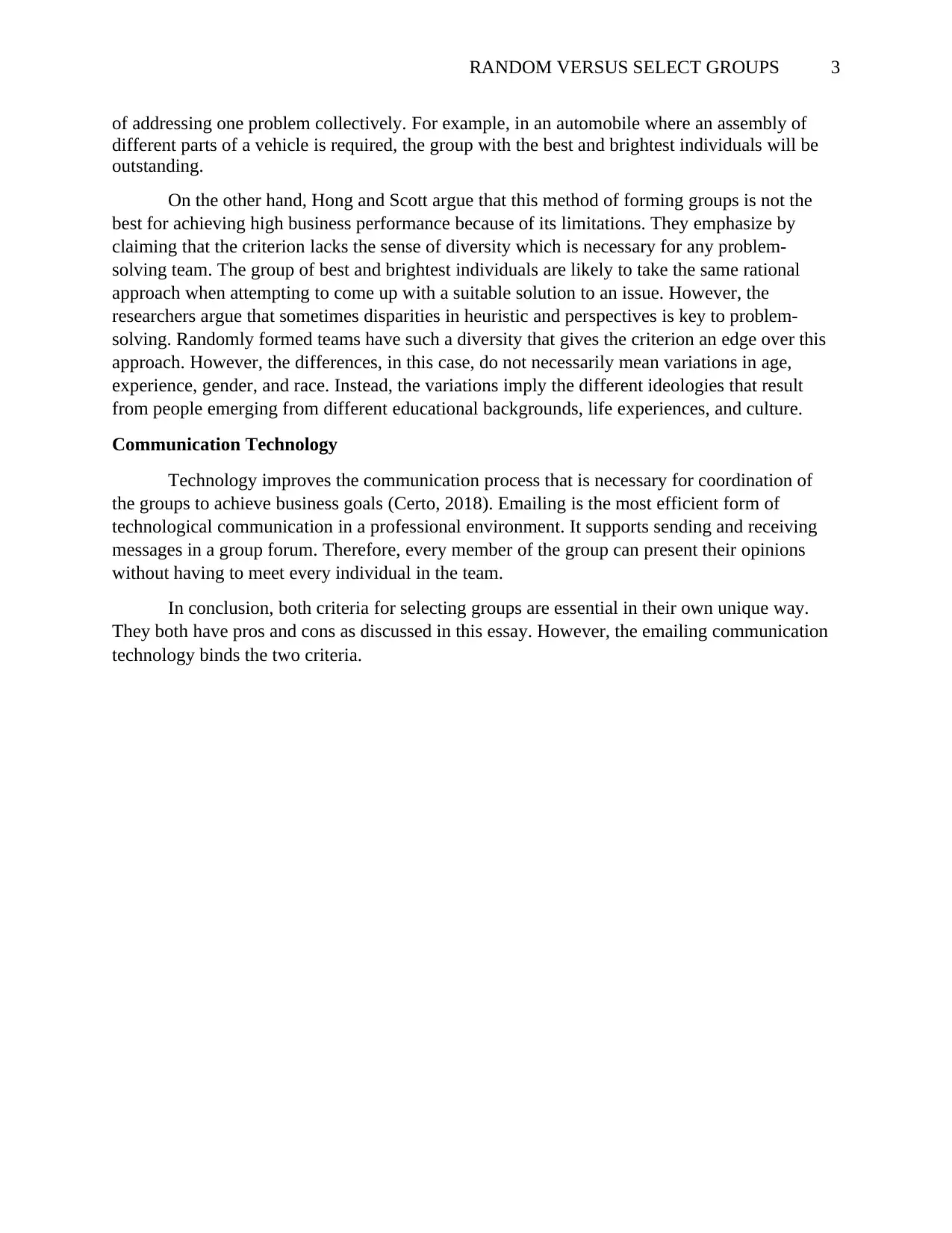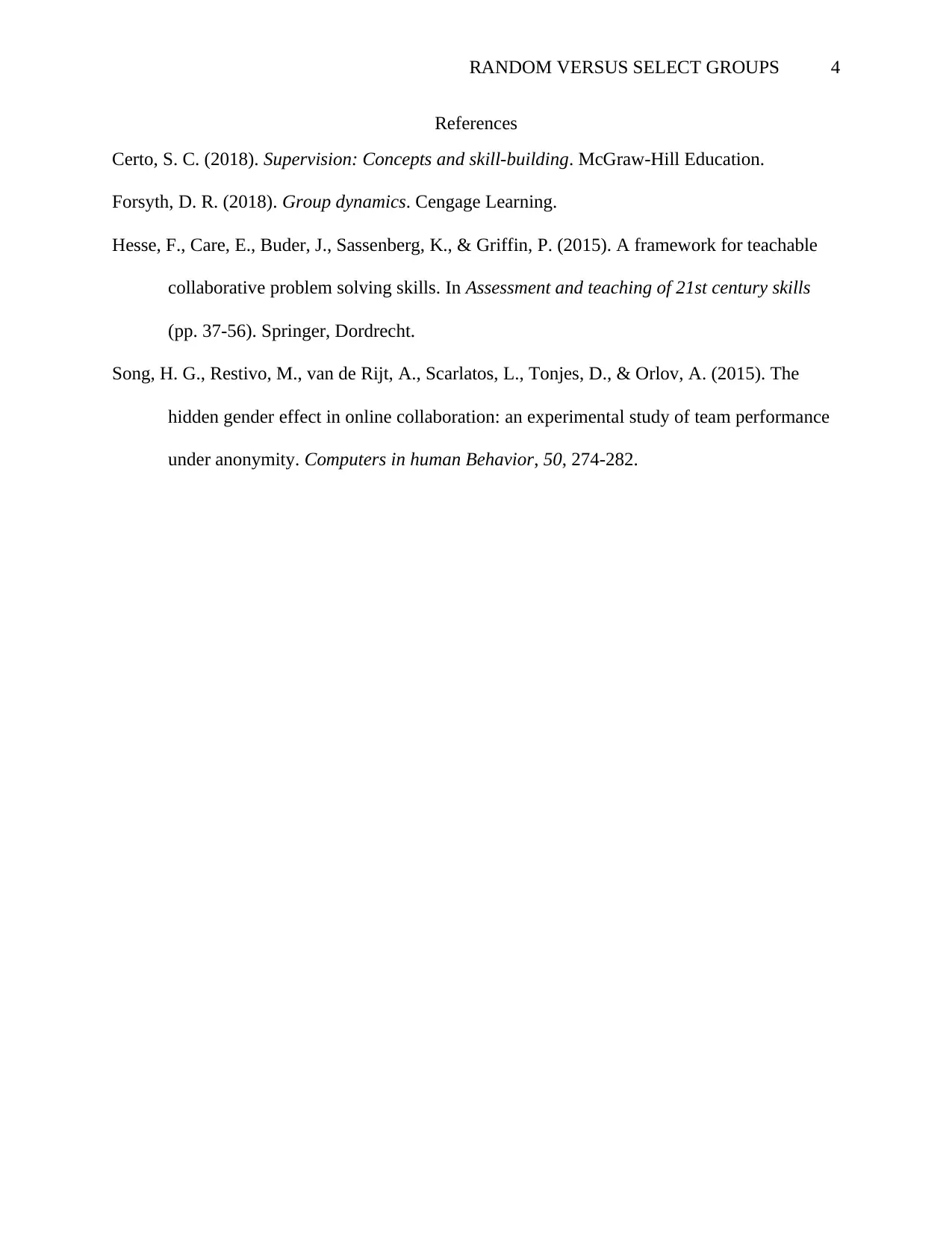Random vs. Select Groups: Analyzing Team Selection Strategies
VerifiedAdded on 2021/06/14
|4
|1120
|27
Essay
AI Summary
This essay examines two methods of workforce team selection: random and select groups. It explores the advantages and disadvantages of each approach, considering factors such as efficiency, team dynamics, and diversity. The essay argues that randomly formed teams often offer benefits like ease of formation, the creation of a friendly environment, and diverse perspectives, which can improve decision-making and problem-solving. Conversely, select groups, composed of individuals with specific knowledge, may facilitate faster decision-making, especially when dealing with coordinated tasks. The essay also considers the role of communication technology, such as email, in facilitating collaboration between team members, and concludes by suggesting that both methods have unique strengths, and the optimal choice depends on the specific context and organizational goals.

Running head: RANDOM VERSUS SELECT GROUPS 1
Random Versus Select Groups
Name:
Institution Affiliation:
Random Versus Select Groups
Name:
Institution Affiliation:
Paraphrase This Document
Need a fresh take? Get an instant paraphrase of this document with our AI Paraphraser

RANDOM VERSUS SELECT GROUPS 2
Random Versus Select Groups
Many workplace environments insist on teamwork in carrying out business activities.
Working as a team creates a friendly and conducive environment for the employees and hence
improves efficiency. Normally, managers or supervisor are responsible for coming up with a
group of employees that are supposed to work together to achieve a specific objective or a
number of organizational goals. There are several criteria for selecting the groups; two of this
methods include selecting teams on a random basis and according to individual knowledge. This
essay attempts to determine the best criterion for selecting a workforce by addressing the pros
and cons for each side. It also addresses the question “how does each group of workforce
improve the decision making and problem-solving aspects of an organization?”
Randomly Formed Teams
Selection of teams based on a random criterion is a common occurrence in the corporate
world. This is because of the advantages it presents to both the supervisors and the general
organization. First and foremost, random selection is an easy and faster method of forming a
team. The manager only needs to come up with the specific criterion to differentiate the team and
then the employees will group themselves accordingly. Secondly, the method ensures that the
workers make new “friends” in the work environment. This is because the randomly formed
teams may contain people that have never interacted with each other before. It creates an
opportunity for knowing one another and hence creates a friendly environment. This facilitates
teamwork and efficient problem solving because the workers are comfortable to consult with
their colleagues. Another advantage is that randomly formed teams contain diverse members that
facilitate good decision making and problem-solving. According to the U-M studies, a diverse
team is likely to perform better than a team of best and brightest individuals (Hesse, Care, Buder,
Sassenberg & Griffin, 2015). This is because the group with best and brightest individuals are
likely to make similar approaches towards a problem. Having the same perspective of an issue is
never an effective way of making business decisions or solving the problems. Similarly, Hong
and Page used mathematical and computational models to determine the best performance
criterion (Song, Restivo, van de Rijt, Scarlatos, Tonjes & Orlov, 2015). Their findings indicated
that the best solutions to a problem were obtained when the team members were diverse than
when the group was selected based on their individual knowledge. Their experiments support the
notion that the group of randomly selected groups is more effective.
Select Groups
This method of forming a group is based on the assumption that a group of best and
brightest individuals can unite to brainstorm their ideas and come up with the best and most
effective solutions to a business problem (Forsyth, 2018). This method has its pros and cons. The
biggest advantage of this process is that decisions are likely to be made at a faster rate. In a
business environment, decision making among executives and board members is very crucial for
ensuring that the business is successful in its operations. In addition, time is a precious resource
that should not be wasted. For these reasons. a faster rate of decision making is an added
advantage to any business decision. Similarly, the solutions to a problem are well thought of
considering that the team is composed of the best and brightest individuals. Organizations’
success depends on the efficiency of solving business problems and making the most effective
decisions for the company. Finally, this the best solution if the solutions are coordinated instead
Random Versus Select Groups
Many workplace environments insist on teamwork in carrying out business activities.
Working as a team creates a friendly and conducive environment for the employees and hence
improves efficiency. Normally, managers or supervisor are responsible for coming up with a
group of employees that are supposed to work together to achieve a specific objective or a
number of organizational goals. There are several criteria for selecting the groups; two of this
methods include selecting teams on a random basis and according to individual knowledge. This
essay attempts to determine the best criterion for selecting a workforce by addressing the pros
and cons for each side. It also addresses the question “how does each group of workforce
improve the decision making and problem-solving aspects of an organization?”
Randomly Formed Teams
Selection of teams based on a random criterion is a common occurrence in the corporate
world. This is because of the advantages it presents to both the supervisors and the general
organization. First and foremost, random selection is an easy and faster method of forming a
team. The manager only needs to come up with the specific criterion to differentiate the team and
then the employees will group themselves accordingly. Secondly, the method ensures that the
workers make new “friends” in the work environment. This is because the randomly formed
teams may contain people that have never interacted with each other before. It creates an
opportunity for knowing one another and hence creates a friendly environment. This facilitates
teamwork and efficient problem solving because the workers are comfortable to consult with
their colleagues. Another advantage is that randomly formed teams contain diverse members that
facilitate good decision making and problem-solving. According to the U-M studies, a diverse
team is likely to perform better than a team of best and brightest individuals (Hesse, Care, Buder,
Sassenberg & Griffin, 2015). This is because the group with best and brightest individuals are
likely to make similar approaches towards a problem. Having the same perspective of an issue is
never an effective way of making business decisions or solving the problems. Similarly, Hong
and Page used mathematical and computational models to determine the best performance
criterion (Song, Restivo, van de Rijt, Scarlatos, Tonjes & Orlov, 2015). Their findings indicated
that the best solutions to a problem were obtained when the team members were diverse than
when the group was selected based on their individual knowledge. Their experiments support the
notion that the group of randomly selected groups is more effective.
Select Groups
This method of forming a group is based on the assumption that a group of best and
brightest individuals can unite to brainstorm their ideas and come up with the best and most
effective solutions to a business problem (Forsyth, 2018). This method has its pros and cons. The
biggest advantage of this process is that decisions are likely to be made at a faster rate. In a
business environment, decision making among executives and board members is very crucial for
ensuring that the business is successful in its operations. In addition, time is a precious resource
that should not be wasted. For these reasons. a faster rate of decision making is an added
advantage to any business decision. Similarly, the solutions to a problem are well thought of
considering that the team is composed of the best and brightest individuals. Organizations’
success depends on the efficiency of solving business problems and making the most effective
decisions for the company. Finally, this the best solution if the solutions are coordinated instead

RANDOM VERSUS SELECT GROUPS 3
of addressing one problem collectively. For example, in an automobile where an assembly of
different parts of a vehicle is required, the group with the best and brightest individuals will be
outstanding.
On the other hand, Hong and Scott argue that this method of forming groups is not the
best for achieving high business performance because of its limitations. They emphasize by
claiming that the criterion lacks the sense of diversity which is necessary for any problem-
solving team. The group of best and brightest individuals are likely to take the same rational
approach when attempting to come up with a suitable solution to an issue. However, the
researchers argue that sometimes disparities in heuristic and perspectives is key to problem-
solving. Randomly formed teams have such a diversity that gives the criterion an edge over this
approach. However, the differences, in this case, do not necessarily mean variations in age,
experience, gender, and race. Instead, the variations imply the different ideologies that result
from people emerging from different educational backgrounds, life experiences, and culture.
Communication Technology
Technology improves the communication process that is necessary for coordination of
the groups to achieve business goals (Certo, 2018). Emailing is the most efficient form of
technological communication in a professional environment. It supports sending and receiving
messages in a group forum. Therefore, every member of the group can present their opinions
without having to meet every individual in the team.
In conclusion, both criteria for selecting groups are essential in their own unique way.
They both have pros and cons as discussed in this essay. However, the emailing communication
technology binds the two criteria.
of addressing one problem collectively. For example, in an automobile where an assembly of
different parts of a vehicle is required, the group with the best and brightest individuals will be
outstanding.
On the other hand, Hong and Scott argue that this method of forming groups is not the
best for achieving high business performance because of its limitations. They emphasize by
claiming that the criterion lacks the sense of diversity which is necessary for any problem-
solving team. The group of best and brightest individuals are likely to take the same rational
approach when attempting to come up with a suitable solution to an issue. However, the
researchers argue that sometimes disparities in heuristic and perspectives is key to problem-
solving. Randomly formed teams have such a diversity that gives the criterion an edge over this
approach. However, the differences, in this case, do not necessarily mean variations in age,
experience, gender, and race. Instead, the variations imply the different ideologies that result
from people emerging from different educational backgrounds, life experiences, and culture.
Communication Technology
Technology improves the communication process that is necessary for coordination of
the groups to achieve business goals (Certo, 2018). Emailing is the most efficient form of
technological communication in a professional environment. It supports sending and receiving
messages in a group forum. Therefore, every member of the group can present their opinions
without having to meet every individual in the team.
In conclusion, both criteria for selecting groups are essential in their own unique way.
They both have pros and cons as discussed in this essay. However, the emailing communication
technology binds the two criteria.
⊘ This is a preview!⊘
Do you want full access?
Subscribe today to unlock all pages.

Trusted by 1+ million students worldwide

RANDOM VERSUS SELECT GROUPS 4
References
Certo, S. C. (2018). Supervision: Concepts and skill-building. McGraw-Hill Education.
Forsyth, D. R. (2018). Group dynamics. Cengage Learning.
Hesse, F., Care, E., Buder, J., Sassenberg, K., & Griffin, P. (2015). A framework for teachable
collaborative problem solving skills. In Assessment and teaching of 21st century skills
(pp. 37-56). Springer, Dordrecht.
Song, H. G., Restivo, M., van de Rijt, A., Scarlatos, L., Tonjes, D., & Orlov, A. (2015). The
hidden gender effect in online collaboration: an experimental study of team performance
under anonymity. Computers in human Behavior, 50, 274-282.
References
Certo, S. C. (2018). Supervision: Concepts and skill-building. McGraw-Hill Education.
Forsyth, D. R. (2018). Group dynamics. Cengage Learning.
Hesse, F., Care, E., Buder, J., Sassenberg, K., & Griffin, P. (2015). A framework for teachable
collaborative problem solving skills. In Assessment and teaching of 21st century skills
(pp. 37-56). Springer, Dordrecht.
Song, H. G., Restivo, M., van de Rijt, A., Scarlatos, L., Tonjes, D., & Orlov, A. (2015). The
hidden gender effect in online collaboration: an experimental study of team performance
under anonymity. Computers in human Behavior, 50, 274-282.
1 out of 4
Your All-in-One AI-Powered Toolkit for Academic Success.
+13062052269
info@desklib.com
Available 24*7 on WhatsApp / Email
![[object Object]](/_next/static/media/star-bottom.7253800d.svg)
Unlock your academic potential
Copyright © 2020–2025 A2Z Services. All Rights Reserved. Developed and managed by ZUCOL.
